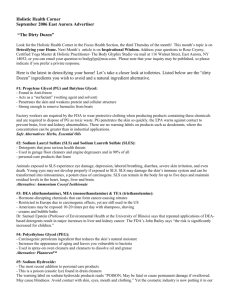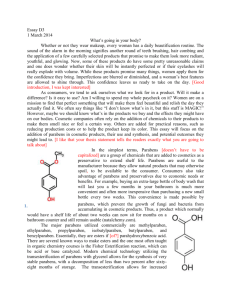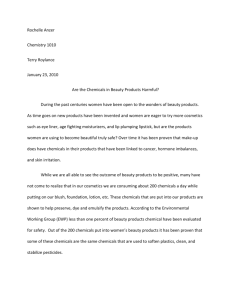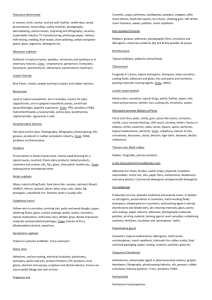Document
advertisement
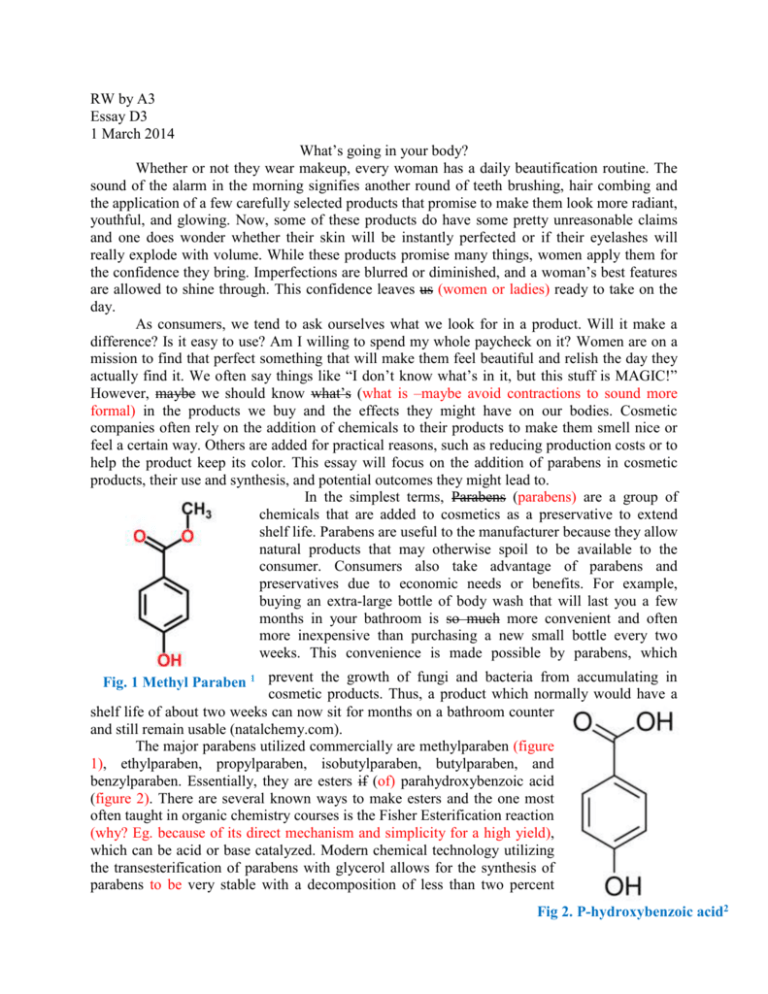
RW by A3 Essay D3 1 March 2014 What’s going in your body? Whether or not they wear makeup, every woman has a daily beautification routine. The sound of the alarm in the morning signifies another round of teeth brushing, hair combing and the application of a few carefully selected products that promise to make them look more radiant, youthful, and glowing. Now, some of these products do have some pretty unreasonable claims and one does wonder whether their skin will be instantly perfected or if their eyelashes will really explode with volume. While these products promise many things, women apply them for the confidence they bring. Imperfections are blurred or diminished, and a woman’s best features are allowed to shine through. This confidence leaves us (women or ladies) ready to take on the day. As consumers, we tend to ask ourselves what we look for in a product. Will it make a difference? Is it easy to use? Am I willing to spend my whole paycheck on it? Women are on a mission to find that perfect something that will make them feel beautiful and relish the day they actually find it. We often say things like “I don’t know what’s in it, but this stuff is MAGIC!” However, maybe we should know what’s (what is –maybe avoid contractions to sound more formal) in the products we buy and the effects they might have on our bodies. Cosmetic companies often rely on the addition of chemicals to their products to make them smell nice or feel a certain way. Others are added for practical reasons, such as reducing production costs or to help the product keep its color. This essay will focus on the addition of parabens in cosmetic products, their use and synthesis, and potential outcomes they might lead to. In the simplest terms, Parabens (parabens) are a group of chemicals that are added to cosmetics as a preservative to extend shelf life. Parabens are useful to the manufacturer because they allow natural products that may otherwise spoil to be available to the consumer. Consumers also take advantage of parabens and preservatives due to economic needs or benefits. For example, buying an extra-large bottle of body wash that will last you a few months in your bathroom is so much more convenient and often more inexpensive than purchasing a new small bottle every two weeks. This convenience is made possible by parabens, which Fig. 1 Methyl Paraben 1 prevent the growth of fungi and bacteria from accumulating in cosmetic products. Thus, a product which normally would have a shelf life of about two weeks can now sit for months on a bathroom counter and still remain usable (natalchemy.com). The major parabens utilized commercially are methylparaben (figure 1), ethylparaben, propylparaben, isobutylparaben, butylparaben, and benzylparaben. Essentially, they are esters if (of) parahydroxybenzoic acid (figure 2). There are several known ways to make esters and the one most often taught in organic chemistry courses is the Fisher Esterification reaction (why? Eg. because of its direct mechanism and simplicity for a high yield), which can be acid or base catalyzed. Modern chemical technology utilizing the transesterification of parabens with glycerol allows for the synthesis of parabens to be very stable with a decomposition of less than two percent Fig 2. P-hydroxybenzoic acid2 after sixty-eight months of storage. The transesterification allows for increased stability due to more acidic conditions (Farsa 41, 42). This is the reason why that extra-large bottle of body wash can last so long in your bathroom! It is quite likely that more than 1. Fisher Mechanism- Acid Catalyst3 half of the products in your bathroom and even some in your kitchen contain parabens. Parabens have been widely used for many years due to their chemical stability and low irritation to consumers. Widespread use of parabens in personal care products has contributed to major exposure. In 2005-2006, The US National Health and Nutrition Examination Survey revealed that ninety-nine percent of all urine samples contained significant concentrations of at least one paraben, regardless of ethnicity and socioeconomic background (Liao 10895). –good statistical data Recently, many researchers have focused their work on assessing the possible health risks of parabens, and the results are somewhat daunting. Several studies have shown that exposure to parabens in personal care products increased the sensitivity of consumers to allergic reactions (…increased consumers’ susceptibility to allergic reactions). It is important to note that parabens are often not used alone in productions, but rather in conjunction with others to enhance the preservative effects. Specifically, Uter, a professor at Friedrich-Alexander-Universität Erlangen-Nürnberg (FAU), discovered that parabens used in conjunction with other chemicals such as triclosan and formaldehyde, create a “cocktail” of substances that would then increase sensitization in consumers (Uter 2). Such combined exposure may possible elicit allergy reactions that are not produced by the single paraben if it were used alone in the product (…that are not produced when a single paraben is used alone in the product.) (Uter 4).These effects also held true for combinations of the several different parabens in use. Further development of cosmetics so that they don’t include sensitizing levels of parabens and preservatives is a good idea. (It is a good idea to further develop cosmetics so that they do not include sensitizing levels of parabens and preservatives.) Decreasing levels of parabens is beneficial not only because of possible allergic reactions, but also due to more (because of the possibility of more) serious health effects. We already know that parabens pass through urine, but remember that products containing parabens are often lotions and antiperspirants, which are not typically ingested. Because parabens are lipophilic (soluble in fats, oils, and lipids), they can be absorbed through the skin and thus are found complete(ly?) or remove in tissue samples (Crinnion 194). As a matter of fact, significant quantities of at least one of the major parabens were found in almost one hundred percent of breast cancer tissue samples (Barr 221). In addition, significant correlations have been discovered 4 between locations of paraben-containing breast cancer tissue; most Fig.4 are found in the axilla area of the breast, coinciding with location of the daily application of Fig. 5 Estrogen 5 antiperspirant (Crinnion 194). The reason for such effects is that parabens are known as a type of endocrine disruptor, meaning that they can interfere with the healthy functioning of a human’s endocrine system. In an extreme sense (extreme cases), endocrine disruptors can cause tumors, birth defects, and other developmental disorders (Nohynek 295). Specifically, parabens have estrogen- mimicking properties, meaning they can bind to estrogen receptors (fig. 4) in the human body. Also, they can increase expression of genes normally regulated by estradiol (figure 5), leading to dysfunction in gene activity. Although research shows that parabens do have “extremely weak” estrogen disrupting properties, remember that (remove), often times there is daily exposure to combinations of these chemicals, and that can have an impact on one’s health (Nohynek 297). In fact, studies have demonstrated that combinations of parabens are present in concentrations sufficient to stimulate the proliferation of breast cancer cells in vitro in several experiments (Charles 395). Thus, daily exposure to combinations of parabens creates health risks and close monitoring of these risks would be beneficial. In addition to possible health concerns, researchers have shown interest in the possible environmental effects of paraben exposure. In fact, the Journal of Agricultural and Food chemistry labels parabens as part of a group of “emerging contaminants” because of their direct and indirect routes of exposure to the human body. Studies have found low concentrations of parabens in marine life due to human use and disposal into sewage systems (Fussell B). This finding means that exposure to parabens is not limited to personal care use and there maybe potential for environmental damage. (, but also extends to potential environmental damage). Increasing concentrations of parabens have been found in sediment and sewage from the United States, Japan, and Korea (Liao 10895). In addition, growing concentrations of the six major parabens have been found in air and dust samples (Liao 10896). A study found that the concentrations for parabens in the environment were in agreement with those reported for human urine, suggesting that parabens continue to have an effect even after they have been utilized and disposed of. (Need to clarify. Are you saying that the disposed of parabens still linger around in the environment and human bodies?) There is also evidence that parabens have the ability to bind and adhere to the organic matter in sediment and sludge (Liao 10898). Further research is obviously necessary to determine risks and the extent of paraben effects on the environment, and to assess eventual decomposition pathways of parabens found in marine life and in sediment, sludge and sewage. Although more research is necessary to learn more about parabens and their exact contributions ( effects on) humans, specifically cancer and the environment, current studies have brought the nature of parabens to light and have helped to increase our awareness. Parabens are now showing up in the conversations of the FDA and various cancer organizations. Many cosmetic companies are making valuable efforts to make their products free of parabens and other potentially harmful chemicals. Consumer awareness is also a major player (factors), since more people find value in knowing what is in their products and place an emphasis on reading labels. Hopefully these combined efforts will help reduce human exposure to ingredients which (that) may be a potential hazard despite their economic significance to the industry. So next time you want to make yourself “more beautiful,” think about the products you are using and what is in them. Works Cited Barr, L. “Measurement of Paraben Concentrations in Human Breast Tissue at Serial Locations Across the Breast from Axilla to Sternum.” Journal of Applied Toxicology 22 (2012): 219-232.Print. Charles, Amelia K. “Combinations of parabens at concentrations measured in human breast tissue can increase proliferation of MCF-7 human breast cancer cells”. Journal of Applied Toxicology 33 (2013): 390-398. Print. Crinnion, Walter J. “Toxic Effects of the Easily Avoidable Pthalates and Parabens.” Alternative Medicine Review 15.3 (2010): 190-196. Print. Farsa, Oldrich. "Hydrolysis and Transesterification of Parabens in an Aqueous Solution in the Presence of Glycerol and Boric Acid." J. Excipients and Food Chem 2.2 (2011): 41-49. Print. Fussell, Richard J. "Investigation into the Occurrence in Food of Veterinary Medicines, Pharmaceuticals, and Chemicals Used in Personal Care Products”. Journal of Agricultural and Food Chemistry. Web. Liao, Chunyang. "Parabens in Sediment and Sewage Sludge from the United States, Japan, and Korea: Spatial Distribution and Temporal Trends." Environmental Science and Technology 47 (2013): 10895-0902. Web. Nohynek, Gerard J. “Endocrine Disruption: Fact or Urban Legend?” Toxicology Letters 223 (2013): 295-305. Print. Uter, Wolfgang. “Coupled Exposure to Ingredients of Cosmetic Products II: Parabens”. Contact Dermatitis (2013): 1-8. Web. "What Are Parabens." Natalchemy. NatalChemy, 2014. Web. 01 Mar. 2014. http://www.natalchemy.com/what-are-parabens.aspx http://www.breastcancerfund.org/clear-science/radiation-chemicals-and-breastcancer/parabens.html Figures: 1. Methyl Paraben: http://www.chemspider.com/ImagesHandler.ashx?id=7176&w=500&h=500 2. Parahydroxy Benzoic Acid: http://www.sigmaaldrich.com/content/dam/sigmaaldrich/structure4/121/mfcd00002547.eps/_jcr_content/renditions/large.png 3. Fisher Esterification: http://upload.wikimedia.org/wikipedia/commons/d/d7/Fischer_esterification_mechanism.svg 4. Estrogen http://marshanunleymd.files.wordpress.com/2011/03/estrogen.gif 5. Estradiol http://en.citizendium.org/images/9/9a/Estradiol_DEVolk.jpg
